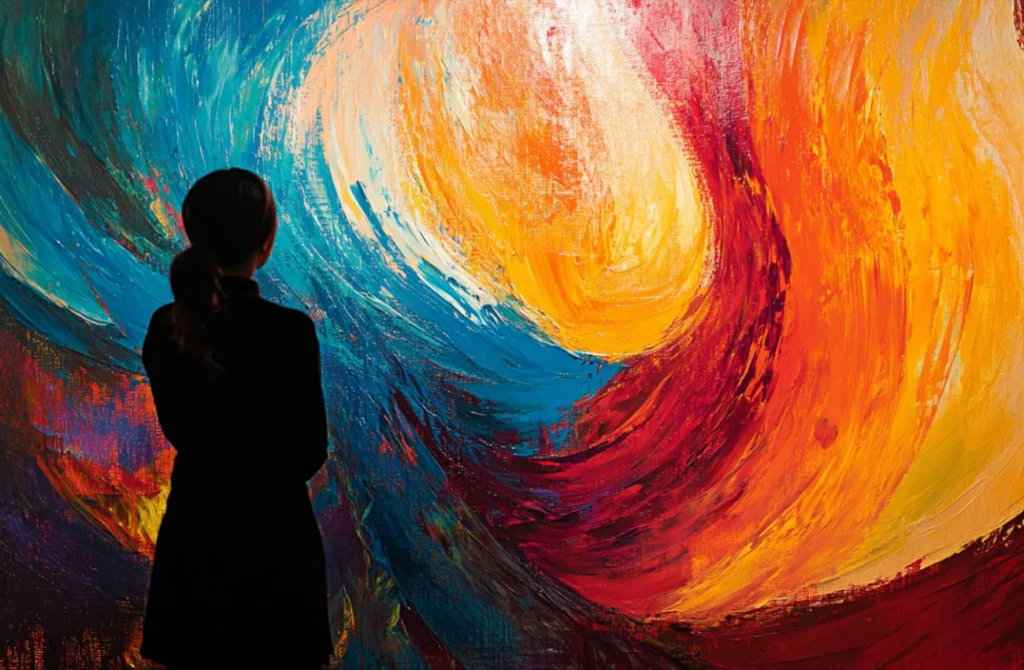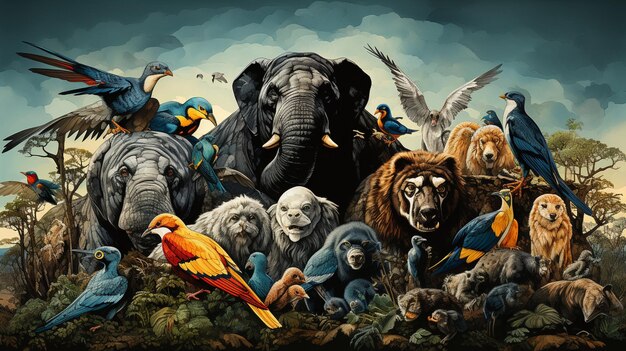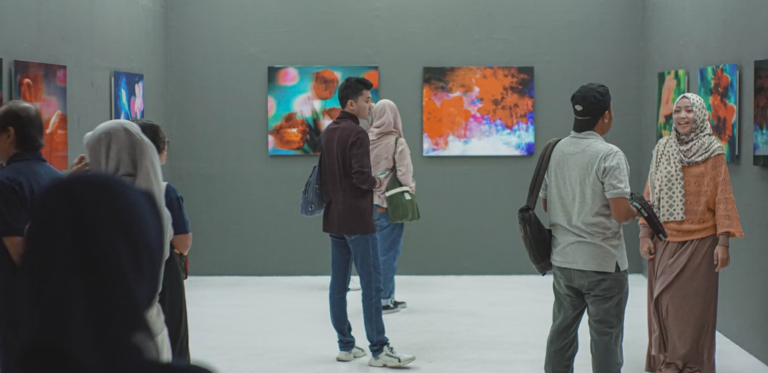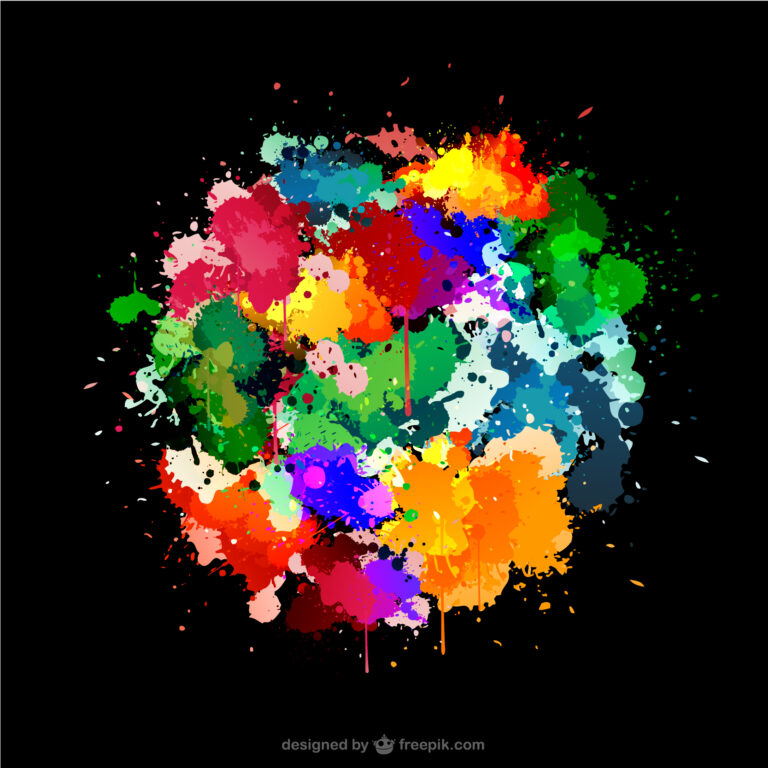Beyond the Canvas: Exploring the World of Abstract Art
What is Abstract Art?
Abstract art uses shapes, colors, and lines to create art that doesn’t necessarily look like anything from the real world. This type of art can be very different from what we see in nature. Instead of trying to show things exactly as they are, abstract artists create their own ideas and feelings through their artwork.
A Change in Art History
For a long time, artists tried to paint things as realistically as possible. But by the end of the 19th century, many artists felt it was time for something new. They wanted to express the changes happening in the world around them, including advancements in technology and science. This led to the rise of abstract art, which focuses more on emotions and ideas than on representing reality.
Terms Related to Abstract Art
Understanding Different Terms
Terms like non-figurative art, non-objective art, and non-representational art are often used interchangeably with abstract art. Although they are similar, they may have slight differences. Abstraction can range from subtle changes to completely non-recognizable forms. For example, some abstract art may still hint at real objects, while other pieces may not resemble anything recognizable at all.
Continuum of Abstraction
Abstraction exists on a spectrum. Some artwork may appear to be realistic at first glance, but upon closer inspection, it might reveal abstract qualities. In contrast, total abstraction involves no references to recognizable forms, like in geometric abstraction, which uses shapes like circles and squares without representing anything from the real world.
The History of Abstract Art
19th Century Beginnings
The roots of abstract art can be traced back to several movements in the 19th century, such as Romanticism, Impressionism, and Expressionism. These movements encouraged artists to explore new ways of seeing and interpreting the world. For instance, James McNeill Whistler’s works focused more on visual sensations than realistic portrayals, paving the way for abstraction.
Influential Artists
Artists like Wassily Kandinsky and Hilma af Klint were pioneers of abstract art. They experimented with shapes and colors to create works that conveyed deeper emotions and ideas rather than just imitating what they saw. By the early 20th century, movements like Fauvism and Cubism had emerged, which further pushed the boundaries of abstraction.

Abstract Art in the 20th Century
Early 20th Century Developments
During the early 1900s, artists like Henri Matisse and Francis Picabia began creating works that broke away from traditional art forms. Kandinsky, in particular, was known for his colorful, abstract compositions. The 1912 Salon de la Section d’Or featured many artists who were experimenting with abstraction, further solidifying this new direction in art.
The Role of Music in Abstract Art
As artists embraced abstraction, they drew inspiration from music. Just as music uses sounds to create emotions, abstract art uses colors and shapes. Kandinsky believed that visual art could resonate with people in the same way music does, creating a deeper connection.
The Influence of the Bauhaus
Founding of the Bauhaus
In 1919, Walter Gropius established the Bauhaus in Germany, a school that combined various forms of art, including painting, architecture, and design. The Bauhaus emphasized the importance of unity in the arts, encouraging artists to explore different materials and techniques. Teachers like Paul Klee and Kandinsky played significant roles in shaping the school’s philosophy and teaching methods.
Abstract Art in the 20th Century
In the early 20th century, abstract art gained momentum as artists experimented with new techniques and materials. Movements like Surrealism and Abstract Expressionism emerged, pushing the boundaries of what art could represent. Artists like Jackson Pollock and Mark Rothko created works that emphasized spontaneity and emotional depth. Pollock’s drip paintings, for example, transformed canvas into a dynamic field of movement, while Rothko’s color fields invited viewers to explore their emotional responses to color and form. This era marked a significant departure from traditional representational art, allowing artists to express complex ideas through abstraction.
The Role of Color in Abstract Art
Color plays a crucial role in abstract art, serving as a primary tool for expression. Artists utilize color to evoke emotions and create visual harmony. For instance, the Fauves, led by Henri Matisse, used bold, non-representational colors to convey feelings rather than depict reality. The choice of colors can influence the viewer’s mood, making abstraction a powerful means of communication. Artists like Wassily Kandinsky believed that colors had spiritual significance, further emphasizing the importance of color in conveying abstract ideas.
Techniques and Styles in Abstract Art
Abstract artists employ various techniques and styles to create their works. Techniques like layering, blending, and juxtaposition allow artists to explore depth and texture. Styles range from geometric abstraction, characterized by clean lines and shapes, to lyrical abstraction, which emphasizes spontaneity and fluidity. Each artist brings their unique perspective, resulting in a diverse array of abstract art forms. This variety invites viewers to interpret and engage with the artwork in personal ways, fostering a deeper connection to the art.
The Influence of Technology on Abstract Art
Technology has significantly impacted the creation and perception of abstract art. With the advent of digital tools, artists can experiment with new forms of expression, combining traditional techniques with modern technology. Digital art allows for endless possibilities, enabling artists to manipulate shapes and colors in ways that were previously unimaginable. This fusion of technology and art expands the boundaries of abstraction, offering fresh perspectives and challenging conventional definitions of art.
Abstract Art in Contemporary Culture
Today, abstract art continues to thrive in contemporary culture. It can be found in various forms, from street art to large-scale installations in galleries. Artists like Yayoi Kusama and Gerhard Richter push the boundaries of abstraction, exploring themes of identity, perception, and the nature of reality. Moreover, abstract art is increasingly accessible, with online platforms allowing artists to share their work with a global audience. This democratization of art fosters diverse interpretations and encourages a broader appreciation of abstract expression.

The Emotional Impact of Abstract Art
One of the most compelling aspects of abstract art is its ability to evoke emotions without relying on recognizable subjects. Viewers often find themselves drawn to the colors, shapes, and textures, which can elicit feelings of joy, sadness, or contemplation. This emotional resonance is a fundamental aspect of abstract art, as it invites personal interpretation and reflection. Artists aim to create a visceral experience, allowing viewers to connect with the artwork on a deeper emotional level.
Conclusion:
The Legacy of Abstract Art
The legacy of abstract art is profound and far-reaching. It has transformed the art world by challenging traditional notions of representation and encouraging experimentation. Abstract art continues to inspire new generations of artists and viewers alike, inviting exploration and dialogue. Its enduring impact on modern art and culture serves as a testament to the power of abstraction in conveying complex ideas and emotions. As we move forward, abstract art will undoubtedly remain a vital part of the artistic landscape, pushing the boundaries of creativity and expression.
FAQs
1. What is abstract art?
Answer: Abstract art is a style of art that does not attempt to represent an accurate depiction of visual reality. Instead, it uses shapes, colors, forms, and gestural marks to create compositions that may exist independently from the visual references in the world.
2. Who are some famous abstract artists?
Answer: Some famous abstract artists include Wassily Kandinsky, Piet Mondrian, Jackson Pollock, Mark Rothko, and Helen Frankenthaler. Each of these artists has made significant contributions to the development of abstract art.
3. How do I appreciate abstract art?
Answer: To appreciate abstract art, focus on your emotional response to the piece. Consider the colors, shapes, and textures used, and think about how they make you feel. There are no right or wrong interpretations in abstract art, so allow your feelings and imagination to guide you.
4. Can anyone create abstract art?
Answer: Yes! Anyone can create abstract art. It encourages personal expression and creativity, allowing individuals to experiment with colors, shapes, and forms without the need for technical skills or traditional artistic training.
5. What materials are commonly used in abstract art?
Answer: Abstract artists use a wide variety of materials, including acrylics, oils, watercolors, charcoal, pastels, and mixed media. The choice of materials often depends on the artist’s preferred style and technique.
What is Abstract Art?
Abstract art uses shapes, colors, and lines to create art that doesn’t necessarily look like anything from the real world. This type of art can be very different from what we see in nature. Instead of trying to show things exactly as they are, abstract artists create their own ideas and feelings through their artwork.
A Change in Art History
For a long time, artists tried to paint things as realistically as possible. But by the end of the 19th century, many artists felt it was time for something new. They wanted to express the changes happening in the world around them, including advancements in technology and science. This led to the rise of abstract art, which focuses more on emotions and ideas than on representing reality.
Terms Related to Abstract Art
Understanding Different Terms
Terms like non-figurative art, non-objective art, and non-representational art are often used interchangeably with abstract art. Although they are similar, they may have slight differences. Abstraction can range from subtle changes to completely non-recognizable forms. For example, some abstract art may still hint at real objects, while other pieces may not resemble anything recognizable at all.
Continuum of Abstraction
Abstraction exists on a spectrum. Some artwork may appear to be realistic at first glance, but upon closer inspection, it might reveal abstract qualities. In contrast, total abstraction involves no references to recognizable forms, like in geometric abstraction, which uses shapes like circles and squares without representing anything from the real world.
The History of Abstract Art
19th Century Beginnings
The roots of abstract art can be traced back to several movements in the 19th century, such as Romanticism, Impressionism, and Expressionism. These movements encouraged artists to explore new ways of seeing and interpreting the world. For instance, James McNeill Whistler’s works focused more on visual sensations than realistic portrayals, paving the way for abstraction.
Influential Artists
Artists like Wassily Kandinsky and Hilma af Klint were pioneers of abstract art. They experimented with shapes and colors to create works that conveyed deeper emotions and ideas rather than just imitating what they saw. By the early 20th century, movements like Fauvism and Cubism had emerged, which further pushed the boundaries of abstraction.
Abstract Art in the 20th Century
Early 20th Century Developments
During the early 1900s, artists like Henri Matisse and Francis Picabia began creating works that broke away from traditional art forms. Kandinsky, in particular, was known for his colorful, abstract compositions. The 1912 Salon de la Section d’Or featured many artists who were experimenting with abstraction, further solidifying this new direction in art.
The Role of Music in Abstract Art
As artists embraced abstraction, they drew inspiration from music. Just as music uses sounds to create emotions, abstract art uses colors and shapes. Kandinsky believed that visual art could resonate with people in the same way music does, creating a deeper connection.
The Influence of the Bauhaus
Founding of the Bauhaus
In 1919, Walter Gropius established the Bauhaus in Germany, a school that combined various forms of art, including painting, architecture, and design. The Bauhaus emphasized the importance of unity in the arts, encouraging artists to explore different materials and techniques. Teachers like Paul Klee and Kandinsky played significant roles in shaping the school’s philosophy and teaching methods.
Abstract Art in the 20th Century
In the early 20th century, abstract art gained momentum as artists experimented with new techniques and materials. Movements like Surrealism and Abstract Expressionism emerged, pushing the boundaries of what art could represent. Artists like Jackson Pollock and Mark Rothko created works that emphasized spontaneity and emotional depth. Pollock’s drip paintings, for example, transformed canvas into a dynamic field of movement, while Rothko’s color fields invited viewers to explore their emotional responses to color and form. This era marked a significant departure from traditional representational art, allowing artists to express complex ideas through abstraction.
The Role of Color in Abstract Art
Color plays a crucial role in abstract art, serving as a primary tool for expression. Artists utilize color to evoke emotions and create visual harmony. For instance, the Fauves, led by Henri Matisse, used bold, non-representational colors to convey feelings rather than depict reality. The choice of colors can influence the viewer’s mood, making abstraction a powerful means of communication. Artists like Wassily Kandinsky believed that colors had spiritual significance, further emphasizing the importance of color in conveying abstract ideas.
Techniques and Styles in Abstract Art
Abstract artists employ various techniques and styles to create their works. Techniques like layering, blending, and juxtaposition allow artists to explore depth and texture. Styles range from geometric abstraction, characterized by clean lines and shapes, to lyrical abstraction, which emphasizes spontaneity and fluidity. Each artist brings their unique perspective, resulting in a diverse array of abstract art forms. This variety invites viewers to interpret and engage with the artwork in personal ways, fostering a deeper connection to the art.
The Influence of Technology on Abstract Art
Technology has significantly impacted the creation and perception of abstract art. With the advent of digital tools, artists can experiment with new forms of expression, combining traditional techniques with modern technology. Digital art allows for endless possibilities, enabling artists to manipulate shapes and colors in ways that were previously unimaginable. This fusion of technology and art expands the boundaries of abstraction, offering fresh perspectives and challenging conventional definitions of art.
Abstract Art in Contemporary Culture
Today, abstract art continues to thrive in contemporary culture. It can be found in various forms, from street art to large-scale installations in galleries. Artists like Yayoi Kusama and Gerhard Richter push the boundaries of abstraction, exploring themes of identity, perception, and the nature of reality. Moreover, abstract art is increasingly accessible, with online platforms allowing artists to share their work with a global audience. This democratization of art fosters diverse interpretations and encourages a broader appreciation of abstract expression.
The Emotional Impact of Abstract Art
One of the most compelling aspects of abstract art is its ability to evoke emotions without relying on recognizable subjects. Viewers often find themselves drawn to the colors, shapes, and textures, which can elicit feelings of joy, sadness, or contemplation. This emotional resonance is a fundamental aspect of abstract art, as it invites personal interpretation and reflection. Artists aim to create a visceral experience, allowing viewers to connect with the artwork on a deeper emotional level.
Conclusion:
The Legacy of Abstract Art
The legacy of abstract art is profound and far-reaching. It has transformed the art world by challenging traditional notions of representation and encouraging experimentation. Abstract art continues to inspire new generations of artists and viewers alike, inviting exploration and dialogue. Its enduring impact on modern art and culture serves as a testament to the power of abstraction in conveying complex ideas and emotions. As we move forward, abstract art will undoubtedly remain a vital part of the artistic landscape, pushing the boundaries of creativity and expression.
FAQs
1. What is abstract art?
Answer: Abstract art is a style of art that does not attempt to represent an accurate depiction of visual reality. Instead, it uses shapes, colors, forms, and gestural marks to create compositions that may exist independently from the visual references in the world.
2. Who are some famous abstract artists?
Answer: Some famous abstract artists include Wassily Kandinsky, Piet Mondrian, Jackson Pollock, Mark Rothko, and Helen Frankenthaler. Each of these artists has made significant contributions to the development of abstract art.
3. How do I appreciate abstract art?
Answer: To appreciate abstract art, focus on your emotional response to the piece. Consider the colors, shapes, and textures used, and think about how they make you feel. There are no right or wrong interpretations in abstract art, so allow your feelings and imagination to guide you.
4. Can anyone create abstract art?
Answer: Yes! Anyone can create abstract art. It encourages personal expression and creativity, allowing individuals to experiment with colors, shapes, and forms without the need for technical skills or traditional artistic training.
5. What materials are commonly used in abstract art?
Answer: Abstract artists use a wide variety of materials, including acrylics, oils, watercolors, charcoal, pastels, and mixed media. The choice of materials often depends on the artist’s preferred style and technique.







